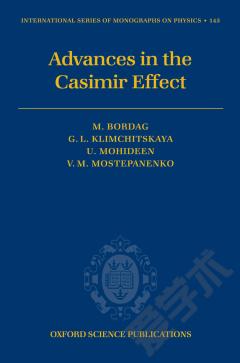Advances in the Casimir Effect
1. Introduction I: PHYSICAL AND MATHEMATICAL FOUNDATIONS OF THE CASIMIR EFFECT FOR IDEAL BOUNDARIES 2. Simple models of the Casimir effect 3. Field quantization and vacuum energy in the presence of boundaries 4. Regularization and renormalization of the vacuum energy 5. The Casimir effect at nonzero temperature 6. Approximate and numerical approaches to the Casimir effect 7. The Casimir effect for two ideal metal planes 8. The Casimir effect in rectangular boxes 9. Single spherical and cylindrical boundaries 10. The Casimir force between objects of arbitrary shape 11. Spaces with non-Euclidean topology II: THE CASIMIR FORCE BETWEEN REAL BODIES 12. The Lifshitz theory of van der Waals and Casimir forces between plane dielectrics 13. The Casimir interaction between plates made of real metals at zero temperature 14. The Casimir interaction between real metals at nonzero temperature 15. The Casimir interaction between metal and dielectric 16. The Lifshitz theory of atom-wall interaction 17. The Casimir force between rough and corrugated surfaces III: MEASUREMENTS OF THE CASIMIR FORCE AND THEIR APPLICATIONS IN BOTH FUNDAMENTAL PHYSICS AND NANOTECHNOLOGY 18. General requirements for Casimir force measurements 19. Measurements of the Casimir force between equals 20. Measurements of the Casimir force with semiconductors 21. Measurements of the Casimir force in configurations with corrugated surfaces 22. Measurement of the Casimir-Polder force 23. Applications of the Casimir force in nanotechnology 24. Constraints on hypothetical interactions from the Casimir effect 25. Conclusions and outlook
{{comment.content}}








 京公网安备 11010802027623号
京公网安备 11010802027623号